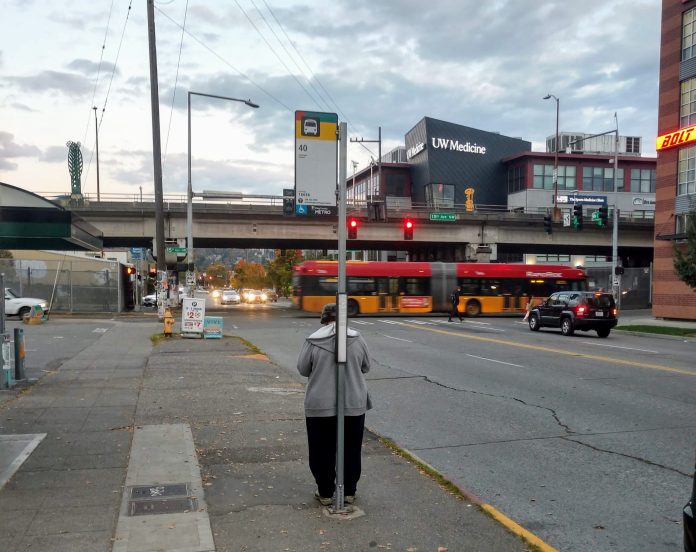To an urbanist, there’s no sweeter sight than fresh red paint claiming a new bus lane.
We have seen that sight a bit more frequently lately. The Seattle Department of Transportation (SDOT) has added about 32 blocks of bus lanes this fall, including stretches on Columbia Street, Olive Way, Pike Street, and Fifth Avenue. Mayor Jenny Durkan’s budget includes another 60 blocks of bus lanes for next year, mostly on Rainier Avenue as funded in the Move Seattle Levy.
It’s good to see the City delivering but so many more bus lanes are needed to keep transit riders out of gridlock, to stretch transit funding farther, to induce more ridership, and to decrease our region’s climbing climate emissions. We’ve been making this case for some time.
One month ahead of the Alaskan Way Viaduct closure, the Move All Seattle Sustainably (MASS) Coalition–of which The Urbanist is a member–issued a list of 20 high-impact bus lanes. We urged the City to add bus lanes as quickly as possible to deal with the Seattle Squeeze, as the City is calling the congested era before the new surface-level Alaskan Way boulevard and big light rail expansions come online. East Link is not due until 2023, and Lynnwood Link and Federal Way Link aren’t scheduled to open until 2024.
For the past decade or so, the Seattle metropolitan area has been leading the nation in transit ridership gains. However, how sustainable is that when so many riders find themselves in Seattle Squeeze gridlock and bus reliability suffers? That is why I’m urging Mayor Durkan to move faster.
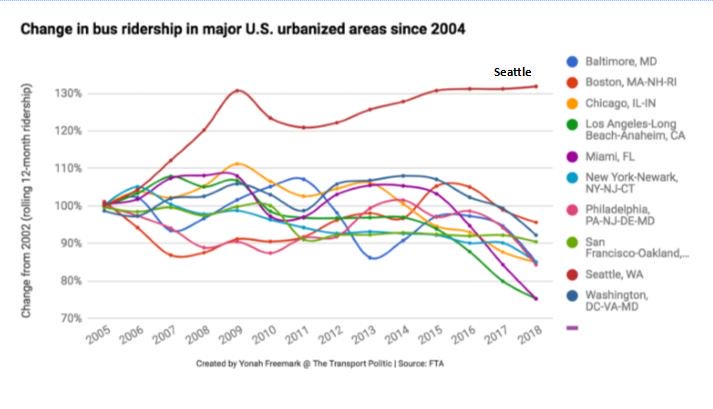
The public supports moving faster; 59% backed the Move Seattle Levy which promised seven RapidRide corridors, with bus lanes being the signature transit improvement. Since then, the Move Seattle program has been reduced and delayed due a budget crunch. As it stands now with no additional funding identified, Move Seattle will not turn Routes 40, 44, and 48 into RapidRides. The other four RapidRide routes have been delayed, but the RapidRide H Line upgrading Delridge’s Route 120 is now slated for 2021. All seven routes deserve red bus lanes as soon as possible regardless of the status of the red “RapidRide” branded buses and bus stops.
We can’t wait for the federal funding mess to sort itself out. We need bus lanes on these corridors now. The Mayor and City Council should deliver on these promised corridors and find funding to double bus lane mileage being delivered in the next year.
The following bus lanes would make a huge impact and could be implemented quickly. The Mayor has prided herself on budget discipline. Here’s a good case to use it:
- Extend planned Rainier Avenue bus lanes to S Jackson Street (Route 7);
- Extend Third Avenue bus lanes to Denny Way (benefits dozens of routes);
- NE 45th Street and 15th Avenue NE (Routes 44, 48, 49, ane 70);
- NW Market Street (Route 44);
- Fairview Avenue in South Lake Union (Route 70);
- Leary Way NW (Routes 40 and 28); and
- SW Alaska Street and 35th Avenue SW (RapidRide C Line and Routes 50 and 37).
The Seattle City Council is about to debate the 2020 budget. They should support the 60 blocks of bus lanes in the budget, but push to double Seattle’s bus lane mileage. Here are the exact stretches of road I’m suggesting bus lanes should go:
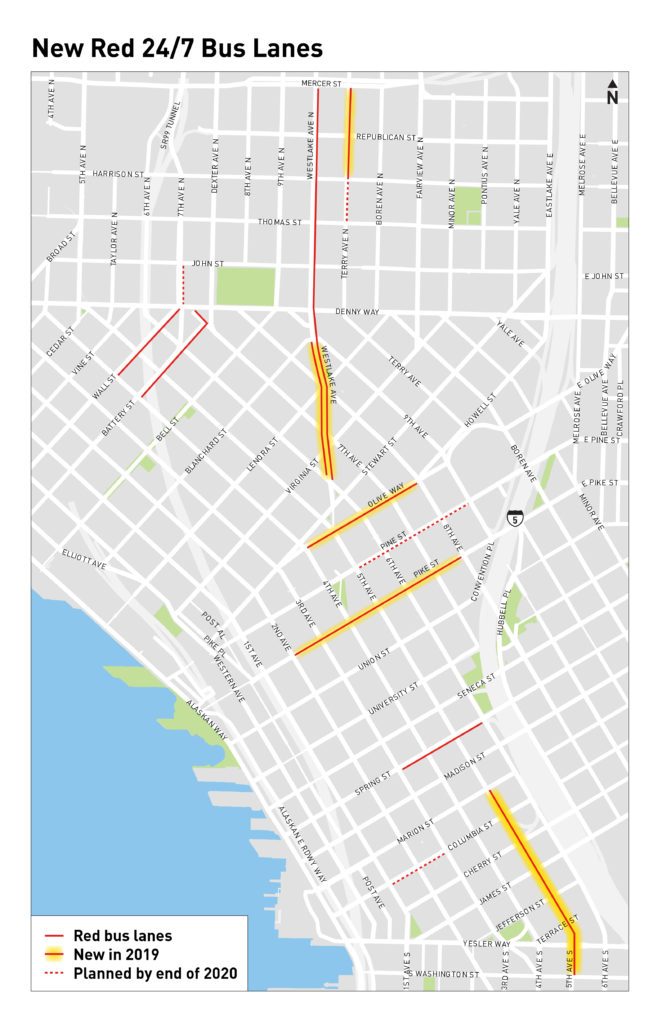
Rainier Avenue: S Bayview St to S Jackson St (1.5 miles)
Rainier Avenue is the centerpiece of the Mayor’s transit proposal. It’s great to see northbound bus lanes along a significant stretch of the corridor. However, a key congested section near I-90 doesn’t have them. This will continue to dog reliability, and needs to be addressed. Rainier Avenue is a RapidRide corridor not seeing full treatment until 2024. The majority of Rainier Valley residents surveyed wanted bus lanes.
Third Avenue: Blanchard St to Denny Way (0.5 miles)
Third Avenue is the heart of the regional bus network and it’s the most buses on one street in the United States. Why we would not make this whole street bus only is beyond me–the MASS coalition urged transit priority along all of Third Avenue in March. More than 100,000 bus riders would benefit. It would help virtually every bus to Northwest Seattle, Magnolia, Queen Anne, and RapidRide D and E Lines. The good news is the Mayor proposes extending the bus-only restrictions a few blocks to Blanchard Street. The bad news is that buses would be on their own for the remaining half-mile through Belltown. Let’s fix that.
NE 45th Street: Latona Ave NE to 15th Ave NE (0.6 miles)
Route 44 gets stuck in gridlocked frequently, particularly in the University District when workers and students file in and out of University of Washington (UW). Route 44 was a RapidRide corridor but is now in Move Seattle Reset limbo. It’s a workhorse and will serve the U District light rail station in 2021. The bus’s routing may change, turning on Brooklyn Avenue NE to pass closer to the station, but since at least some bus will continue to use NE 45th Street east of Brooklyn Avenue NE, we might as well claim it.
15th Avenue NE: Pacific St to NE 45th St (0.6 miles)
15th Avenue NE is a major bus artery serving UW, with Routes 44, 48, 49, 70, and 271 all relying on it. Those routes represent more than 30,000 daily riders by my quick count. Bus lanes would save tons of bus riders time and spare service hours while furthering mobility goals for the campus, which aim to lower drive-alone rates and lower carbon emissions.
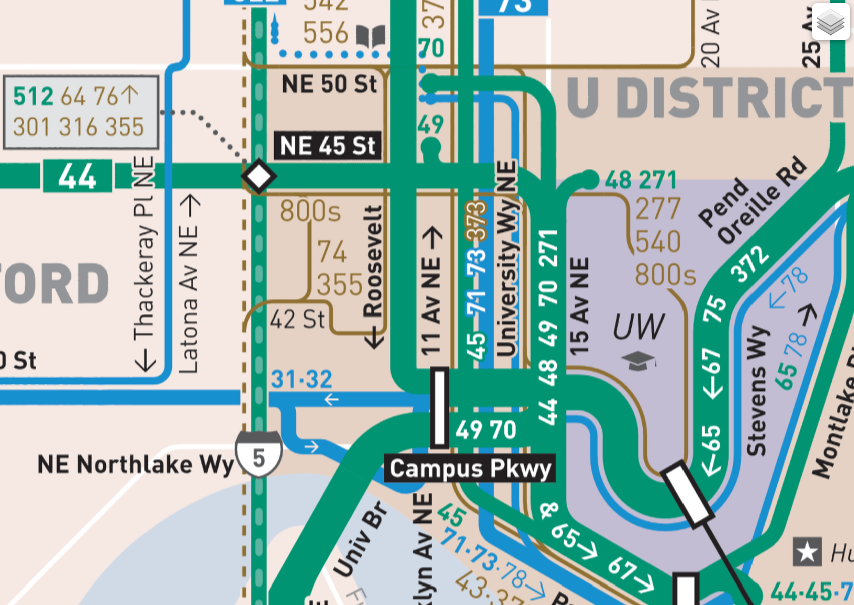
NW Market Street: 17th Ave NW to 3rd Ave NW (0.9 miles)

The western end of Route 44 is also mired in congestion. Market Street has four lanes (plus on-street parking or a center turn lane in some sections) and the interior lanes don’t serve much purpose but unsafe passes and to encourage motorists to speed. Claiming them for bus lanes would make the street safer too, in addition to improving transit.
Fairview Avenue: Boren Ave to Valley St (0.5 miles)
Congestion in South Lake Union is legendary. We have to offer a way out. Route 70 is getting known for unreliability and crowding and could greatly benefit from Fairview Avenue bus lanes. Route 70 will be RapidRide J Line via the Move Seattle Levy, but full RapidRide rollout is pushed back to 2024. That said, the City is planning as-of-yet undisclosed changes starting in 2021 and has a online open house. Whether that’s Eastlake Avenue bike lanes, Fairview Avenue bus lanes, both, or neither remains to be seen. Painting Fairview Avenue bus lanes in 2020 would be a win and an action up to the scale of the Seattle Squeeze and climate emergency.
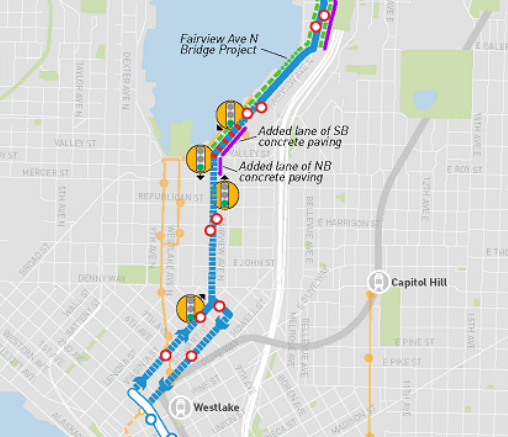
Leary Way NW: NW 39th St to NW Market St (1.6 miles)
Route 40 is the busiest bus that’s not already a RapidRide–in 2017 it averaged 12,000 daily boardings. But it’s not a joy to ride. Congestion squeezes it at several points along the route, and it gets bunched and crowded. The Ballard congestion is the easiest to deal with because Leary Way NW is a five-lane road with no parking for most of its length. Paint the curb lane red and turn it into a Business Access and Transit (BAT) lane. Route 28 would also benefit between N 39th Street and 8th Avenue NW.

SW Alaska Street: 35th Ave SW to California Ave SW (0.5 miles)
West Seattle buses have suffered worst of all in the Seattle Squeeze, having lost their former pathway into Downtown. The new Alaskan Way surface boulevard will address this with bus lanes, but congestion is also an issue within West Seattle, too. Bus lanes on Alaska Street along the path of the RapidRide C Line (plus Routes 37 and 50) would help address this.
35th Avenue SW: SW Alaska St to Avalon Way SW (0.2 miles)
A short stretch, but given four lanes on 35th Avenue SW in this section, it makes sense to grab two for BAT lanes to keep RapidRide C Line and friends out of through-traffic here. Route 21 would also benefit.
RapidRide Rollout Schedule after "Reset"
| RapidRide Corridor | 1st Revision | Reset Date | Existing Route | 2015 Daily Ridership | 2016 Daily Ridership | Platform Hours |
|---|---|---|---|---|---|---|
| Madison "G" | 2021 | 2021 | 12 | 3,500 | 3,300 | 84 |
| Delridge "H" | 2020 | 2021 | 120 | 8,700 | 8,600 | 226 |
| Rainier | 2021 | 2024 | 7 | 11,500 | 10,800 | 255 |
| Roosevelt | 2021 | 2024 | 70 | 5,300 | 7,500 | 182 |
| Market/45th St | 2022 | cut? | 44 | 7,500 | 8,400 | 167 |
| Fremont | 2023 | cut? | 40 | 10,600 | 11,400 | 284 |
| E 23rd Ave | 2024 | cut? | 48 | 11,200 | 5,500 | 183 |
| West Seattle | 2012 | 2012 | C | 8,800 | 11,100 | 289 |
| 15th Ave NW | 2012 | 2012 | D | 11,800 | 14,300 | 256 |
| Aurora Ave | 2014 | 2014 | E | 15,800 | 17,000 | 299 |
6.5 Miles of Bus Lanes in All
All told it’s about six and a half miles of bus lanes, but it would have a huge impact. This would roughly double the bus lane mileage the Mayor has budgeted or delivered thus far in her term. It would keep the momentum Seattle has raising transit ridership and cutting carbon emissions per capita. Let’s claim the lane for climate.
Doug Trumm is publisher of The Urbanist. An Urbanist writer since 2015, he dreams of pedestrian streets, bus lanes, and a mass-timber building spree to end our housing crisis. He graduated from the Evans School of Public Policy and Governance at the University of Washington in 2019. He lives in Seattle's Fremont neighborhood and loves to explore the city by foot and by bike.

